by Calculated Risk on 2/24/2022 12:20:00 PM
Thursday, February 24, 2022
January New Home Sales: Record 106 thousand Homes Have Not been Started
Today, in the Calculated Risk Real Estate Newsletter: January New Home Sales: Record 106 thousand Homes Have Not been Started
Brief excerpt:
The next graph shows new home sales for 2021 and 2022 by month (Seasonally Adjusted Annual Rate). Sales in January 2022 were down 19.3% from January 2021 (new home sales were very strong at the end of 2020 and in January 2021).You can subscribe at https://calculatedrisk.substack.com/.
The year-over-year comparisons will be easier going forward.
...
The next graph shows the months of supply by stage of construction. “Months of supply” is inventory at each stage, divided by the sales rate.
The inventory of completed homes for sale was at 37 thousand in January, up from the record low of 33 thousand in March through July 2021. That is about 0.6 months of completed supply (red line). This is about half the normal level.
The inventory of new homes under construction is at 3.9 months (blue line) - well above the normal level. This elevated level of homes under construction is due to supply chain constraints.
And 106 thousand homes have not been started - about 1.6 months of supply (grey line) - almost double the normal level. Homebuilders are probably waiting to start some homes until they have a firmer grasp on prices.
New Home Sales decrease to 801,000 Annual Rate in January
by Calculated Risk on 2/24/2022 10:12:00 AM
The Census Bureau reports New Home Sales in January were at a seasonally adjusted annual rate (SAAR) of 801 thousand.
The previous three months were revised up.
Sales of new single‐family houses in January 2022 were at a seasonally adjusted annual rate of 801,000, according to estimates released jointly today by the U.S. Census Bureau and the Department of Housing and Urban Development. This is 4.5 percent below the revised December rate of 839,000 and is 19.3 percent below the January 2021 estimate of 993,000.
emphasis added
 Click on graph for larger image.
Click on graph for larger image.The first graph shows New Home Sales vs. recessions since 1963. The dashed line is the current sales rate.
New home sales are now declining year-over-year since sales soared following the first few months of the pandemic.
The second graph shows New Home Months of Supply.
 The months of supply increased in January to 6.1 months from 5.6 months in December.
The months of supply increased in January to 6.1 months from 5.6 months in December. The all-time record high was 12.1 months of supply in January 2009. The all-time record low was 3.5 months, most recently in October 2020.
This is at the top of the normal range (about 4 to 6 months of supply is normal).
"The seasonally‐adjusted estimate of new houses for sale at the end of January was 406,000. This represents a supply of 6.1 months at the current sales rate."
 The last graph shows sales NSA (monthly sales, not seasonally adjusted annual rate).
The last graph shows sales NSA (monthly sales, not seasonally adjusted annual rate).In January 2021 (red column), 64 thousand new homes were sold (NSA). Last year, 77 thousand homes were sold in January.
The all-time high for January was 92 thousand in 2005, and the all-time low for January was 21 thousand in 2011.
This was slightly below expectations, however sales in the three previous months were revised up sharply. I'll have more later today.
Weekly Initial Unemployment Claims Decrease to 232,000
by Calculated Risk on 2/24/2022 08:36:00 AM
The DOL reported:
In the week ending February 19, the advance figure for seasonally adjusted initial claims was 232,000, a decrease of 17,000 from the previous week's revised level. The previous week's level was revised up by 1,000 from 248,000 to 249,000. The 4-week moving average was 236,250, a decrease of 7,250 from the previous week's revised average. The previous week's average was revised up by 250 from 243,250 to 243,500.The following graph shows the 4-week moving average of weekly claims since 1971.
emphasis added
 Click on graph for larger image.
Click on graph for larger image.The dashed line on the graph is the current 4-week average. The four-week average of weekly unemployment claims decreased to 236,250.
The previous week was revised up.
Weekly claims were close to the consensus forecast.
Q4 GDP Growth Revised up to 7.0% Annual Rate
by Calculated Risk on 2/24/2022 08:33:00 AM
From the BEA: Gross Domestic Product, Fourth Quarter and Year 2021 (Second Estimate)
Real gross domestic product (GDP) increased at an annual rate of 7.0 percent in the fourth quarter of 2021, according to the "second" estimate released by the Bureau of Economic Analysis. In the third quarter, real GDP increased 2.3 percent.Here is a Comparison of Second and Advance Estimates. PCE growth was revised down from 3.3% to 3.1%. Residential investment was revised up from -0.8% to 1.0%.
The GDP estimate released today is based on more complete source data than were available for the "advance" estimate issued last month. In the advance estimate, the increase in real GDP was 6.9 percent. The updated estimates primarily reflected upward revisions to nonresidential fixed investment, state and local government spending, and residential fixed investment that were partly offset by downward revisions to personal consumption expenditures (PCE) and exports.
emphasis added
Black Knight: National Mortgage Delinquency Rate Decreased in January; "Foreclosure Starts Surge"
by Calculated Risk on 2/24/2022 12:01:00 AM
Note: At the beginning of the pandemic, the delinquency rate increased sharply (see table below). Loans in forbearance are counted as delinquent in this survey, but those loans are not reported as delinquent to the credit bureaus.
From Black Knight: Black Knight: Foreclosure Starts Surge Sevenfold in January, Hitting Highest Level in Two Years; Though Volumes Rising, Still 20% Below Pre-Pandemic Levels
• Foreclosure starts rose sharply in January as borrower protections in place throughout the economic recovery begin to roll off, with 32,900 loans referred to foreclosure in the monthAccording to Black Knight's First Look report, the percent of loans delinquent decreased 2.3% in January compared to December and decreased 44% year-over-year.
• While up significantly from December’s 4,100, January’s start volume was still more than 20% below the 42,800 in January 2020, prior to the onset of the COVID-19 pandemic
• Roughly half of the month’s starts were among borrowers who were already delinquent prior to the economic impacts of COVID-19, and half from borrowers who became past due in March 2020 or later
• In turn, the national foreclosure rate rose to its highest level since May 2021 (0.28%) – still nearly 40% below its pre-pandemic level, with foreclosure sales (completions) 70% below January 2020 levels
• At the same time, the national delinquency rate continued to improve, and the number of seriously past due mortgages fell by 87,000 (-9%) as borrowers leaving forbearance plans returned to making payments
• A backlog of post-forbearance loans in active loss mitigation – plus another 379,000 that have finished loss mitigation but remain past due – calls for a close watch on foreclosure metrics in coming months
• Prepayment activity hit a more than two-year low, falling by 24% from the month prior as rising rates continue to put sharp downward pressure on refinance incentive
emphasis added
The percent of loans in the foreclosure process increased 16.5% in January and were down 13% over the last year.
Black Knight reported the U.S. mortgage delinquency rate (loans 30 or more days past due, but not in foreclosure) was 3.30% in January, down from 3.38% in December.
The percent of loans in the foreclosure process increased in January to 0.28%, from 0.24% in December.
The number of delinquent properties, but not in foreclosure, is down 1,372,000 properties year-over-year, and the number of properties in the foreclosure process is down 22,000 properties year-over-year.
| Black Knight: Percent Loans Delinquent and in Foreclosure Process | ||||
|---|---|---|---|---|
| Jan 2022 | Dec 2021 | Jan 2021 | Jan 2020 | |
| Delinquent | 3.30% | 3.38% | 5.85% | 3.22% |
| In Foreclosure | 0.28% | 0.24% | 0.32% | 0.46% |
| Number of properties: | ||||
| Number of properties that are delinquent, but not in foreclosure: | 1,758,000 | 1,799,000 | 3,130,000 | 1,705,000 |
| Number of properties in foreclosure pre-sale inventory: | 149,000 | 128,000 | 171,000 | 246,000 |
| Total Properties | 1,907,000 | 1,927,000 | 3,301,000 | 2,047,000 |
Wednesday, February 23, 2022
Thursday: New Home Sales, GDP, Unemployment Claims
by Calculated Risk on 2/23/2022 09:00:00 PM
Thursday:
• At 8:30 AM ET, the initial weekly unemployment claims report will be released. The consensus is for a decrease to 240 thousand from 248 thousand last week.
• Also, at 8:30 AM, Gross Domestic Product, 4th quarter 2021 (Second estimate). The consensus is that real GDP increased 7.0% annualized in Q4, up from the advance estimate of 6.9%.
• Also, at 8:30 AM, Chicago Fed National Activity Index for January. This is a composite index of other data.
• At 10:00 AM, New Home Sales for January from the Census Bureau. The consensus is that new home sales decreased to 807 thousand SAAR, down from 811 thousand in December.
• At 11:00 AM, the Kansas City Fed manufacturing survey for February
On COVID (focus on hospitalizations and deaths):
| COVID Metrics | ||||
|---|---|---|---|---|
| Now | Week Ago | Goal | ||
| Percent fully Vaccinated | 64.8% | --- | ≥70.0%1 | |
| Fully Vaccinated (millions) | 215.1 | --- | ≥2321 | |
| New Cases per Day3 | 79,539 | 133,392 | ≤5,0002 | |
| Hospitalized3 | 56,222 | 77,791 | ≤3,0002 | |
| Deaths per Day3 | 1,602 | 2,096 | ≤502 | |
| 1 Minimum to achieve "herd immunity" (estimated between 70% and 85%). 2my goals to stop daily posts, 37-day average for Cases, Currently Hospitalized, and Deaths 🚩 Increasing 7-day average week-over-week for Cases, Hospitalized, and Deaths ✅ Goal met. | ||||
 Click on graph for larger image.
Click on graph for larger image.This graph shows the daily (columns) and 7-day average (line) of deaths reported.
"Mortgage Rates Hit New Multi-Year Highs"; Highest Since 2019
by Calculated Risk on 2/23/2022 04:59:00 PM
From Matthew Graham at MortgageNewsDaily: Mortgage Rates Hit New Multi-Year Highs
It was another bad day for the mortgage market. This has been the norm so far in 2022 as financial markets continue repositioning for less and less support from the Federal Reserve.
There were no major new developments on that front today. Bonds (which underlie mortgage rates) simply drifted into moderately weaker territory. In so doing, they ignored several potential justifications to improve. This gives the impression that rates simply took an opportunity to catch their breath as investors weighed the implications of geopolitical risk surrounding Ukraine.
Today's average mortgage rates aren't significantly higher than the previous highs, but nonetheless the highest we've seen since May 2019. The average conventional 30yr fixed is now closer to 4.25% than 4.125%
 Click on graph for larger image.
Click on graph for larger image.This is a graph from Mortgage News Daily (MND) showing 30-year fixed rates from three sources (MND, MBA, Freddie Mac) since 2010.
Real House Prices, Price-to-Rent Ratio and Price-to-Median Income in December and a look at "Affordability"
by Calculated Risk on 2/23/2022 10:53:00 AM
Today, in the Calculated Risk Real Estate Newsletter: Real House Prices, Price-to-Rent Ratio and Price-to-Median Income in December
Excerpt:
In October 2004, Fed economist John Krainer and researcher Chishen Wei wrote a Fed letter on price to rent ratios: House Prices and Fundamental Value. Kainer and Wei presented a price-to-rent ratio using the OFHEO house price index and the Owners' Equivalent Rent (OER) from the BLS.
Note that OER is lagging behind other measures of recent rent increases.
Here is a similar graph using the Case-Shiller National and Composite 20 House Price Indexes. This graph shows the price to rent ratio (January 2000 = 1.0). The price-to-rent ratio had been moving more sideways but picked up significantly recently.On a price-to-rent basis, the Case-Shiller National index is at a record high, and the Composite 20 index is back to June 2005 levels.
By all of the above measures, house prices appear elevated.
emphasis added
AIA: "Architecture billings continue growth" in January
by Calculated Risk on 2/23/2022 08:52:00 AM
Note: This index is a leading indicator primarily for new Commercial Real Estate (CRE) investment.
From the AIA: Architecture billings continue growth into 2022
Architecture firms began 2022 with a slight improvement in business conditions, according to a new report today from The American Institute of Architects (AIA).
AIA’s Architecture Billings Index (ABI) score for January was 51.0 compared to 51.0 in December (any score over 50 indicates billings growth). Inquiries into new work and the value of new design contracts both remained strong with scores of 61.9 and 56.1 respectively.
“Architecture billings, while remaining at very healthy levels in recent months, have slowed considerably from the middle of last year,” said AIA Chief Economist, Kermit Baker, Hon. AIA, PhD. “This no doubt reflects delays in the construction sector caused by supply challenges for both labor and materials, as well as ongoing staffing constraints at architecture firms.”
...
• Regional averages: South (61.2); Midwest (51.5); West (47.6); Northeast (46.8)
• Sector index breakdown: mixed practice (59.3); commercial/industrial (54.2); multi-family residential (50.1); institutional (47.3)
emphasis added
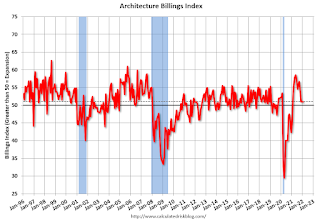 Click on graph for larger image.
Click on graph for larger image.This graph shows the Architecture Billings Index since 1996. The index was at 51.0 in January, unchanged from 51.0 in December. Anything above 50 indicates expansion in demand for architects' services.
Note: This includes commercial and industrial facilities like hotels and office buildings, multi-family residential, as well as schools, hospitals and other institutions.
This index has been positive for the last twelve months.
MBA: Mortgage Applications Decrease in Latest Weekly Survey
by Calculated Risk on 2/23/2022 07:00:00 AM
From the MBA: Mortgage Applications Decrease in Latest MBA Weekly Survey
Mortgage applications decreased 13.1 percent from one week earlier, according to data from the Mortgage Bankers Association’s (MBA) Weekly Mortgage Applications Survey for the week ending February 18, 2022.
... The Refinance Index decreased 16 percent from the previous week and was 56 percent lower than the same week one year ago. The seasonally adjusted Purchase Index decreased 10 percent from one week earlier. The unadjusted Purchase Index decreased 6 percent compared with the previous week and was 6 percent lower than the same week one year ago.
Mortgage applications dropped to their lowest level since December 2019 last week, as mortgage rates continued to inch higher. The 30-year fixed rate was 4.06 percent, almost a full percentage point higher than a year ago. Higher mortgage rates have quickly shut off refinances, with activity down in six of the first seven weeks of 2022. Conventional refinances in particular saw a 17 percent decrease last week,” said Joel Kan, MBA’s Associate Vice President of Economic and Industry Forecasting. “Purchase applications, already constrained by elevated sales prices and tight inventory, have also been impacted by these higher rates and declined for the third straight week. While the average loan size did not increase this week, it remained close to the survey’s record high.”
...
The average contract interest rate for 30-year fixed-rate mortgages with conforming loan balances ($647,200 or less) increased to 4.06 percent from 4.05 percent, with points increasing to 0.48 from 0.45 (including the origination fee) for 80 percent loan-to-value ratio (LTV) loans.
emphasis added
 Click on graph for larger image.
Click on graph for larger image.The first graph shows the refinance index since 1990.
The second graph shows the MBA mortgage purchase index
 According to the MBA, purchase activity is down 6% year-over-year unadjusted.
According to the MBA, purchase activity is down 6% year-over-year unadjusted.Note: Red is a four-week average (blue is weekly).
Tuesday, February 22, 2022
"Mortgage Rates Edging Back Up Toward Long-Term Highs"
by Calculated Risk on 2/22/2022 09:01:00 PM
From Matthew Graham at Mortgage News Daily: Mortgage Rates Edging Back Up Toward Long-Term Highs
The average lender is now roughly 0.04 higher than they were on Friday afternoon, but not yet back to the recent multi-year highs seen at the beginning of last week. That said, they're close enough to those highs that the average borrower won't be able to see a difference in this afternoon's loan quote. [30 year fixed 4.12%]Wednesday:
emphasis added
• At 7:00 AM ET, The Mortgage Bankers Association (MBA) will release the results for the mortgage purchase applications index.
• During the day: The AIA's Architecture Billings Index for January (a leading indicator for commercial real estate).
On COVID (focus on hospitalizations and deaths):
| COVID Metrics | ||||
|---|---|---|---|---|
| Now | Week Ago | Goal | ||
| Percent fully Vaccinated | 64.8% | --- | ≥70.0%1 | |
| Fully Vaccinated (millions) | 215.0 | --- | ≥2321 | |
| New Cases per Day3 | 78,306 | 145,931 | ≤5,0002 | |
| Hospitalized3 | 80,185 | 107,772 | ≤3,0002 | |
| Deaths per Day3 | 1,597 | 2,228 | ≤502 | |
| 1 Minimum to achieve "herd immunity" (estimated between 70% and 85%). 2my goals to stop daily posts, 37-day average for Cases, Currently Hospitalized, and Deaths 🚩 Increasing 7-day average week-over-week for Cases, Hospitalized, and Deaths ✅ Goal met. | ||||
 Click on graph for larger image.
Click on graph for larger image.This graph shows the daily (columns) and 7-day average (line) of deaths reported.
February Vehicle Sales Forecast: Decrease to 14.2 million SAAR
by Calculated Risk on 2/22/2022 06:33:00 PM
From WardsAuto: Volume Up But February’s U.S. Light-Vehicle SAAR Set to Decline from January (pay content)
Supply issues continue to impact vehicle sales, but it appears the supply chain disruption bottom is in.

This graph shows actual sales from the BEA (Blue), and Wards forecast for January (Red).
The Wards forecast of 14.2 million SAAR, would be down about 6% from last month, and down 11% from a year ago (sales were solid in February 2021, as sales recovered from the depths of the pandemic, and weren't yet impacted by supply chain issues).
MBA Survey: "Share of Mortgage Loans in Forbearance Decreases to 1.30% in January"
by Calculated Risk on 2/22/2022 04:00:00 PM
Note: This is as of January 31st.
From the MBA: Share of Mortgage Loans in Forbearance Decreases to 1.30% in January
The Mortgage Bankers Association’s (MBA) monthly Loan Monitoring Survey revealed that the total number of loans now in forbearance decreased by 11 basis points from 1.41% of servicers’ portfolio volume in the prior month to 1.30% as of January 31, 2022. According to MBA’s estimate, 650,000 homeowners are in forbearance plans.
The share of Fannie Mae and Freddie Mac loans in forbearance decreased 4 basis points to 0.68%. Ginnie Mae loans in forbearance decreased 3 basis points to 1.60%, and the forbearance share for portfolio loans and private-label securities (PLS) declined 41 basis points to 3.02%.
“For the second straight month, the pace of forbearance exits reached another low since MBA began tracking exits in June 2020,” said Marina Walsh, CMB, MBA’s Vice President of Industry Analysis. “There was also a pick-up in new forbearance requests and re-entries for all loans, and particularly for Ginnie Mae loans. Even though the forbearance rate continued its downward trajectory, it was the smallest monthly decline since January 2021.”
Added Walsh, “The positive news is that the percentage of borrowers who were current on their mortgage payments increased from December 2021. However, there was some deterioration in the performance of borrowers with existing loan workouts. Borrowers in loan workouts may have experienced new life events unrelated to the pandemic, or alternatively, the omicron variant may have triggered or re-triggered employment, health, or other stresses.”
emphasis added
 Click on graph for larger image.
Click on graph for larger image.This graph shows the percent of portfolio in forbearance by investor type over time. The number of forbearance plans is decreasing.
A few comments on the Seasonal Pattern for House Prices
by Calculated Risk on 2/22/2022 01:09:00 PM
A few key points:
1) There is a clear seasonal pattern for house prices.
2) The surge in distressed sales during the housing bust distorted the seasonal pattern.
3) Even though distressed sales are down significantly, the seasonal factor is based on several years of data - and the factor is now closer to normal (second graph below).
4) Still the seasonal index is probably a better indicator of actual price movements than the Not Seasonally Adjusted (NSA) index.
For in depth description of these issues, see Jed Kolko's article from 2014 "Let’s Improve, Not Ignore, Seasonal Adjustment of Housing Data"
Note: I was one of several people to question the change in the seasonal factor (here is a post in 2009) - and this led to S&P Case-Shiller questioning the seasonal factor too (from April 2010). I still use the seasonal factor (I think it is better than using the NSA data).

This graph shows the month-to-month change in the NSA Case-Shiller National index since 1987 (through December 2021). The seasonal pattern was smaller back in the '90s and early '00s and increased once the bubble burst.
The seasonal swings declined following the bubble, however the recent price surge changed the month-over-month pattern.
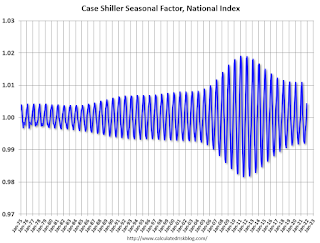
The swings in the seasonal factors have decreased, and the seasonal factors has been moving back towards more normal levels.
Comments on Case-Shiller and FHFA House Price Increases
by Calculated Risk on 2/22/2022 10:37:00 AM
Today, in the Calculated Risk Real Estate Newsletter: Case-Shiller National Index up 18.8% Year-over-year in December
Excerpt:
This graph below shows existing home months-of-supply (inverted, from the NAR) vs. the seasonally adjusted month-to-month price change in the Case-Shiller National Index (both since January 1999 through December 2021).
Note that the months-of-supply is not seasonally adjusted.
There is a clear relationship, and this is no surprise (but interesting to graph). If months-of-supply is high, prices decline. If months-of-supply is very low (like now), prices rise quickly.
In December, the months-of-supply was at 1.7 months, and the Case-Shiller National Index (SA) increased 1.31% month-over-month. The black arrow points to the December 2021 dot. In the January existing home sales report, the NAR reported months-of-supply decreased to a record low 1.6 months in January.
My sense is the Case-Shiller National annual growth rate of 19.98% in August was probably the peak YoY growth rate, however, since the normal level of inventory is probably in the 4 to 6 months range - we’d have to see a significant increase in inventory to sharply slow price increases, and that is why I’m focused on inventory!
Note: I’ll have more on real prices, price-to-rent and affordability tomorrow.emphasis added
Case-Shiller: National House Price Index increased 18.8% year-over-year in December
by Calculated Risk on 2/22/2022 09:12:00 AM
S&P/Case-Shiller released the monthly Home Price Indices for December ("December" is a 3-month average of October, November and December prices).
This release includes prices for 20 individual cities, two composite indices (for 10 cities and 20 cities) and the monthly National index.
From S&P: S&P Corelogic Case-Shiller Index Reports 18.8% Annual Home Price Gain for Calendar 2021
The S&P CoreLogic Case-Shiller U.S. National Home Price NSA Index, covering all nine U.S. census divisions, reported an 18.8% annual gain in December, remaining the same from the previous month. The 10-City Composite annual increase came in at 17.0%, up from 16.9% in the previous month. The 20-City Composite posted an 18.6% year-over-year gain, up from 18.3% in the previous month.
Phoenix, Tampa, and Miami reported the highest year-over-year gains among the 20 cities in December. Phoenix led the way with a 32.5% year-over-year price increase, followed by Tampa with a 29.4% increase and Miami with a 27.3% increase. Fifteen of the 20 cities reported higher price increases in the year ending December 2021 versus the year ending November 2021.
...
Before seasonal adjustment, the U.S. National Index posted a 0.9% month-over-month increase in December, while the 10-City and 20-City Composites posted increases of 1.0% and 1.1%, respectively.
After seasonal adjustment, the U.S. National Index posted a month-over-month increase of 1.3%, and the 10-City and 20-City Composites posted increases of 1.4% and 1.5%, respectively.
In December, all 20 cities reported increases before and after seasonal adjustments.
“We have noted that for the past several months, home prices have been rising at a very high, but decelerating rate. The deceleration paused in December, as year-over-year changes in all three composite indices were slightly ahead of their November levels. December’s 18.8% gain for the National Composite is the fifth-highest reading in history. [says Craig J. Lazzara, Managing Director at S&P DJI]. ...
“We have previously suggested that the strength in the U.S. housing market is being driven in part by a change in locational preferences as households react to the COVID pandemic. More data will be required to understand whether this demand surge simply represents an acceleration of purchases that would have occurred over the next several years rather than a more permanent secular change. In the short term, meanwhile, we should soon begin to see the impact of increasing mortgage rates on home prices.”
emphasis added
 Click on graph for larger image.
Click on graph for larger image. The first graph shows the nominal seasonally adjusted Composite 10, Composite 20 and National indices (the Composite 20 was started in January 2000).
The Composite 10 index is up 1.4% in December (SA).
The Composite 20 index is up 1.5% (SA) in December.
The National index is 50% above the bubble peak (SA), and up 1.3% (SA) in December. The National index is up 105% from the post-bubble low set in February 2012 (SA).
 The second graph shows the year-over-year change in all three indices.
The second graph shows the year-over-year change in all three indices.The Composite 10 SA is up 17.0% year-over-year. The Composite 20 SA is up 18.6% year-over-year.
The National index SA is up 18.8% year-over-year.
Price increases were above expectations. I'll have more later.
Monday, February 21, 2022
Tuesday: Case-Shiller House Prices, Richmond Fed Mfg
by Calculated Risk on 2/21/2022 08:55:00 PM
Tuesday:
• At 9:00 AM ET, FHFA House Price Index for December 2021. This was originally a GSE only repeat sales, however there is also an expanded index.
• Also at 9:00 AM, S&P/Case-Shiller House Price Index for December. The consensus is for a 18.2% year-over-year increase in the Comp 20 index for December.
• At 10:00 AM, Richmond Fed Survey of Manufacturing Activity for February.
Final Look at Local Housing Markets in January
by Calculated Risk on 2/21/2022 12:53:00 PM
Today, in the Calculated Risk Real Estate Newsletter: Final Look at Local Housing Markets in January
A brief excerpt:
This update adds Columbus, Illinois, Indiana, Miami, New York and Phoenix.There is much more in the article. You can subscribe at https://calculatedrisk.substack.com/
...
Here is a summary of active listings for these housing markets in January. Inventory was down 10.2% in January month-over-month (MoM) from December, and down 31.8% year-over-year (YoY).
Inventory almost always declines seasonally in January, so the MoM decline is not a surprise. Last month, these markets were down 29.4% YoY, so the YoY decline in January was larger than in December. This isn’t indicating a slowing market.
Notes for all tables:
1. New additions to table in BOLD.
2. Northwest (Seattle), North Texas (Dallas), and Santa Clara (San Jose), Jacksonville, Source: Northeast Florida Association of REALTORS®
3. Totals do not include Atlanta, Denver, Minneapolis (included in state totals).
Housing Inventory February 21st Update: Inventory Down Slightly Week-over-week; New Record Low
by Calculated Risk on 2/21/2022 10:07:00 AM
Tracking existing home inventory is very important in 2022.
Inventory usually declines in the winter, and this is a new record low for this series.
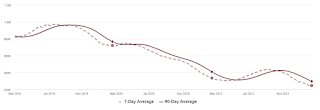
This inventory graph is courtesy of Altos Research.
| Week Ending | YoY Change |
|---|---|
| 12/31/2021 | -30.0% |
| 1/7/2022 | -26.0% |
| 1/14/2022 | -28.6% |
| 1/21/2022 | -27.1% |
| 1/28/2022 | -25.9% |
| 2/4/2022 | -27.9% |
| 2/11/2022 | -27.5% |
| 2/18/2022 | -25.8% |
Mike Simonsen discusses this data regularly on Youtube.
Six High Frequency Indicators for the Economy
by Calculated Risk on 2/21/2022 08:50:00 AM
These indicators are mostly for travel and entertainment. It is interesting to watch these sectors recover as the pandemic subsides.
The TSA is providing daily travel numbers.
This data is as of February 19th.
 Click on graph for larger image.
Click on graph for larger image.This data shows the 7-day average of daily total traveler throughput from the TSA for 2019 (Light Blue), 2020 (Black), 2021 (Blue) and 2022 (Red).
The dashed line is the percent of 2019 for the seven-day average.
The 7-day average is down 17.0% from the same day in 2019 (83.0% of 2019). (Dashed line)
The second graph shows the 7-day average of the year-over-year change in diners as tabulated by OpenTable for the US and several selected cities.
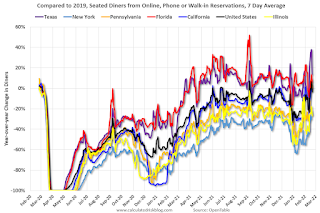 Thanks to OpenTable for providing this restaurant data:
Thanks to OpenTable for providing this restaurant data:This data is updated through February 19, 2022.
This data is "a sample of restaurants on the OpenTable network across all channels: online reservations, phone reservations, and walk-ins. For year-over-year comparisons by day, we compare to the same day of the week from the same week in the previous year."
Dining was mostly moving sideways but declined during the winter wave of COVID and is now increasing. The 7-day average for the US is down 3% compared to 2019.
 This data shows domestic box office for each week and the median for the years 2016 through 2019 (dashed light blue).
This data shows domestic box office for each week and the median for the years 2016 through 2019 (dashed light blue). Note that the data is usually noisy week-to-week and depends on when blockbusters are released.
Movie ticket sales were at $81 million last week, down about 57% from the median for the week.
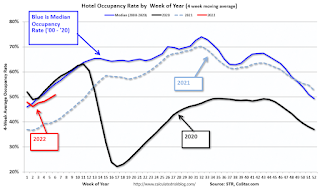 This graph shows the seasonal pattern for the hotel occupancy rate using the four-week average.
This graph shows the seasonal pattern for the hotel occupancy rate using the four-week average. The red line is for 2022, black is 2020, blue is the median, and dashed light blue is for 2021.
This data is through February 12th. The occupancy rate was down 14.0% compared to the same week in 2019.
Notes: Y-axis doesn't start at zero to better show the seasonal change.
This graph is from Apple mobility. From Apple: "This data is generated by counting the number of requests made to Apple Maps for directions in select countries/regions, sub-regions, and cities." This is just a general guide - people that regularly commute probably don't ask for directions.
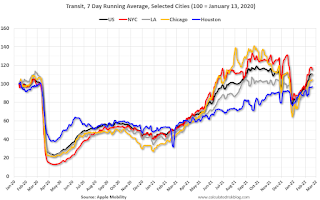 This data is through February 19th
This data is through February 19th The graph is the running 7-day average to remove the impact of weekends.
IMPORTANT: All data is relative to January 13, 2020. This data is NOT Seasonally Adjusted. People walk and drive more when the weather is nice, so I'm just using the transit data.
According to the Apple data directions requests, public transit in the 7-day average for the US is at 110% of the January 2020 level.
Here is some interesting data on New York subway usage (HT BR).
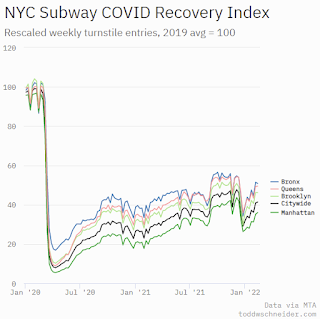 This graph is from Todd W Schneider.
This graph is from Todd W Schneider. This data is through Friday, February 18th.
He notes: "Data updates weekly from the MTA’s public turnstile data, usually on Saturday mornings".




